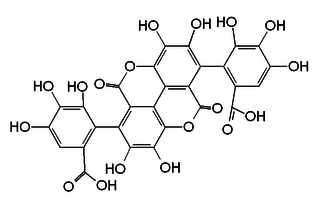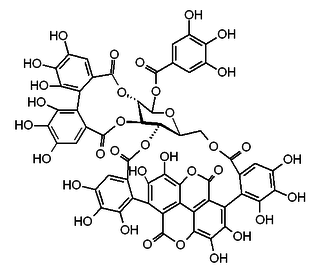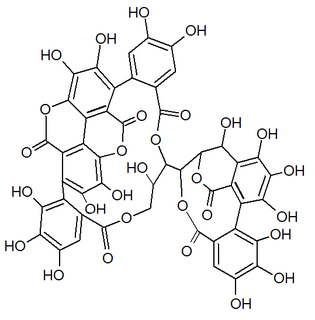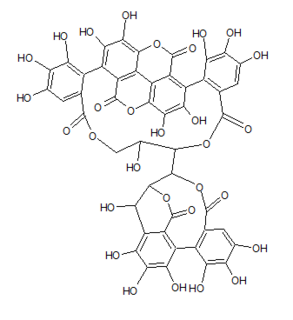 W
WThe pomegranate ellagitannins, which include punicalagin isomers, are ellagitannins found in the fruit, rind (peel), bark or heartwood of pomegranates.
 W
WCasuarinin is an ellagitannin. It is found in the pericarp of pomegranates. It is also found in Casuarina and Stachyurus species and in Alnus sieboldiana.
 W
WCorilagin is an ellagitannin. Corilagin was first isolated in 1951 from Dividivi extract and from Caesalpinia coriaria, hence the name of the molecule. It can also be found in Alchornea glandulosa and in the leaves of Punica granatum (pomegranate).
 W
WEllagic acid is a natural phenol antioxidant found in numerous fruits and vegetables. The antiproliferative and antioxidant properties of ellagic acid have prompted research into its potential health benefits, but it has been identified by the U.S. Food and Drug Administration as a fake cancer cure. Ellagic acid is the dilactone of hexahydroxydiphenic acid.
 W
WGallagic acid is a polyphenolic chemical compound that can be found in the ellagitannins, a type of tannin, found in Punica granatum (pomegranate). It is a building block of the corresponding tannin punicalagin, punicalin, punicacortein C and 2-O-galloyl-punicalin.
 W
W1-α-O-Galloylpunicalagin is an ester of gallic acid and punicalagin, a type of ellagitannin. It is found in the pomegranate and in Combretum glutinosum.
 W
WGranatin A is an ellagitannin found in the pericarp of Punica granatum (pomegranate). It is a weak carbonic anhydrase inhibitor.
 W
WGranatin B is an ellagitannin found in the fruit of Punica granatum (pomegranate). It is a molecule having an enantiomeric dehydrohexahydroxydiphenoyl group.
 W
WPedunculagin is an ellagitannin. It is formed from casuarictin via the loss of a gallate group.
 W
WPunicacortein A is an ellagitannin, a polyphenol compound. It is found in the bark of Punica granatum (pomegranate) and in Osbeckia chinensis.
 W
WPunicacortein B is an ellagitannin, a polyphenol compound. It is found in the bark of Punica granatum (pomegranate).
 W
WPunicacortein C is an ellagitannin, a phenolic compound. It is found in the bark of Punica granatum (pomegranate). The molecule contains a gallagic acid component.
 W
WPunicacortein D is an ellagitannin, a type of phenolic compound. It is found in the bark and heartwood of Punica granatum (pomegranate). The molecule contains a gallagic acid component.
 W
WPunicafolin is an ellagitannin from the leaves of Punica granatum (pomegranate) and in Phyllanthus emblica.
 W
WPunicalagin is an ellagitannin, a type of phenolic compound. It is found in forms alpha and beta in pomegranates, in Terminalia catappa and Terminalia myriocarpa, and in Combretum molle, the velvet bushwillow, a plant species found in South Africa. These three genera are all Myrtales and the last two are both Combretaceae.
 W
WPunicalin is an ellagitannin. It can be found in Punica granatum (pomegranate) or in the leaves of Terminalia catappa, a plant used to treat dermatitis and hepatitis. It is also reported in Combretum glutinosum, all three species being Myrtales, the two last being Combretaceae.
 W
WPunigluconin is an ellagitannin, a polyphenol compound. It is found in the bark of Punica granatum (pomegranate) and in Emblica officinalis. It is a molecule having a hexahydroxydiphenic acid group and two gallic acids attached to a gluconic acid core.